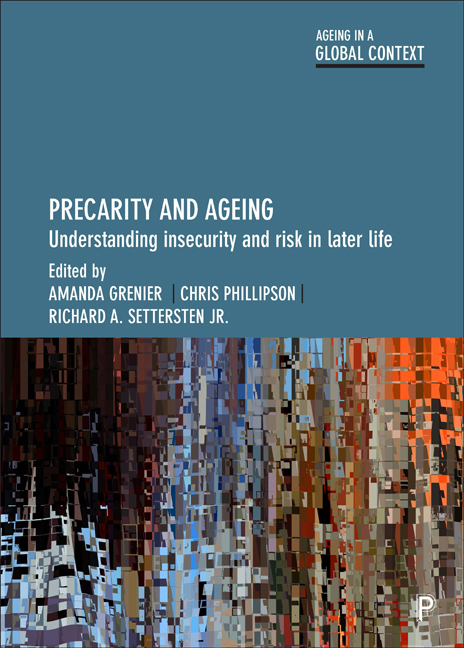Book contents
- Frontmatter
- Contents
- List of Figures and Tables
- Notes on Contributors
- Editors’ Acknowledgements
- Series Editors’ Preface
- 1 Precarity and Ageing: New Perspectives for Social Gerontology
- PART I Life Course Perspectives on Precarity
- PART II Precarity Across Situations
- PART III Austerity, Care and Social Responses to Precarity
- Index
2 - How Life Course Dynamics Matter for Precarity in Later Life
Published online by Cambridge University Press: 02 March 2021
- Frontmatter
- Contents
- List of Figures and Tables
- Notes on Contributors
- Editors’ Acknowledgements
- Series Editors’ Preface
- 1 Precarity and Ageing: New Perspectives for Social Gerontology
- PART I Life Course Perspectives on Precarity
- PART II Precarity Across Situations
- PART III Austerity, Care and Social Responses to Precarity
- Index
Summary
Introduction
What can a life course perspective reveal about precarity? The ‘personological’ paradigm of life course research (Dannefer and Settersten, 2010) attempts to account for how individuals’ past experiences affect later ones. However, a life course perspective on ageing is much more than understanding the shadow of the past or studying a phenomenon over time. The ‘institutional’ paradigm of life course research (Dannefer and Settersten, 2010) emphasizes the role of social forces in opening and closing opportunities and structuring pathways through life. Both of these paradigms provide important lessons for understanding precarity: when, where, how and for whom precarity occurs, and what legacies precarity carries in the lives of individuals, families and societies. I begin with three broad propositions informed by these paradigms – that there is a need to understand precarity across levels, domains and time (inspired by Bernardi et al's (2019) ‘life course cube’) – before turning to more specific insights about how life course dynamics matter for precarity in later life.
Precarity occurs across multiple, often interacting, ‘levels’
Understanding precarity relies on explicitly differentiating between three distinct and interacting levels of analysis: inner-individual, individual and supra-individual (Bernardi et al, 2019). The innerindividual level comprises variables like genetic, biological, physiological and psychological attributes (such as dispositions, values, attitudes and subjective well-being). The individual level comprises ‘biographical’ variables that reflect social and behavioural statuses and outcomes – such as education, whom one lives with or where one lives, social class, or special legal rights or social privileges (such as citizenship or gender) – and which affect the type and amount of resources an individual has to invest or to act. The supra-individual level comprises attributes of the external sociocultural environments in which an individual's behaviour takes place, environments that potentially affect individual opportunities, choices and behaviours. These range from the immediate environment (such as personal and professional relationships and networks) to larger social institutions (such as educational and health care systems or workplaces), together with more distal contexts (such as the economy, culture, demography, and historical events and periods of social change).
These levels, and the interactions between them, are key spaces for understanding precarity. For instance, precarity might stem from interactions between the supra and individual levels. Consider demography. First, declining fertility, combined with increases in life expectancy, have created longer and more interdependent relationships among family members.
- Type
- Chapter
- Information
- Precarity and AgeingUnderstanding Insecurity and Risk in Later Life, pp. 19 - 40Publisher: Bristol University PressPrint publication year: 2020

